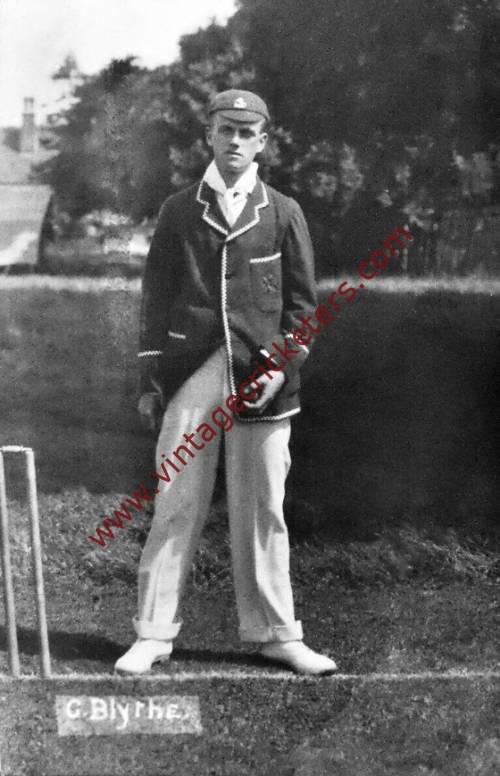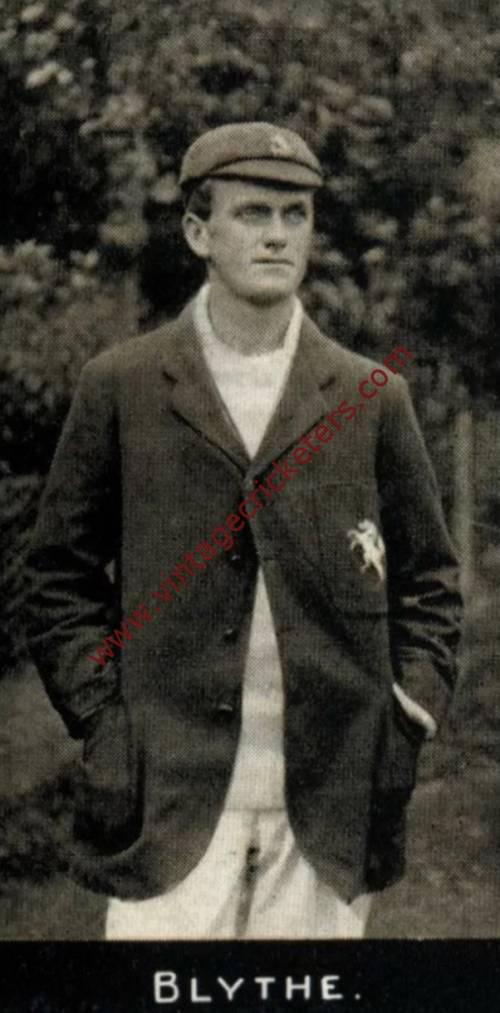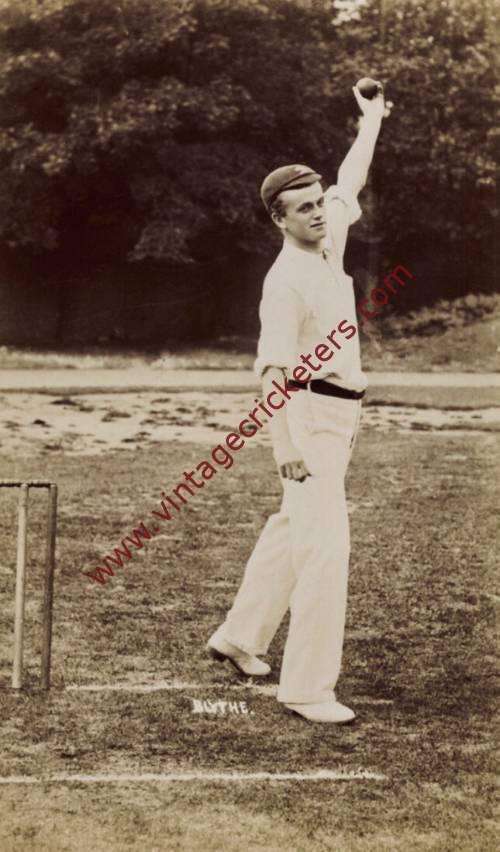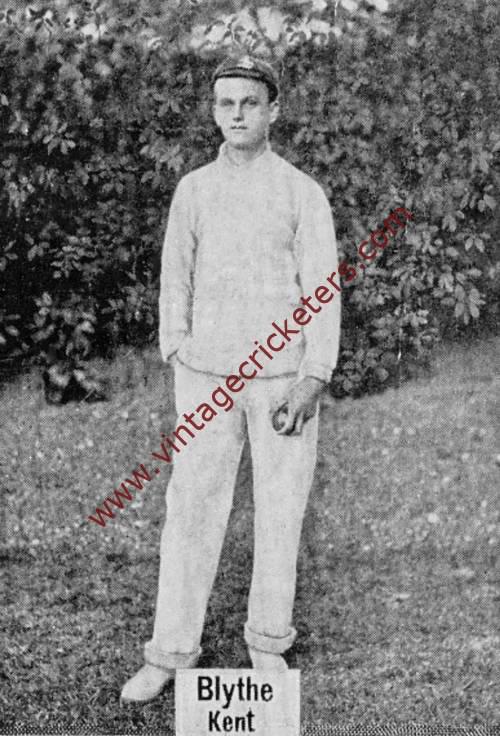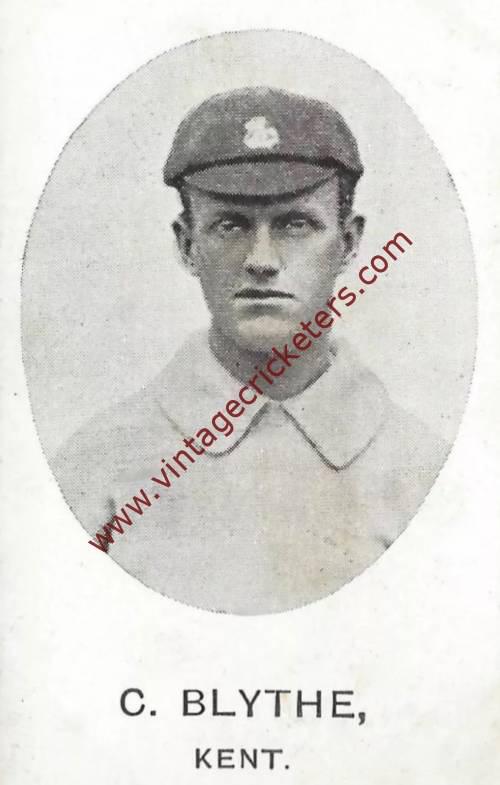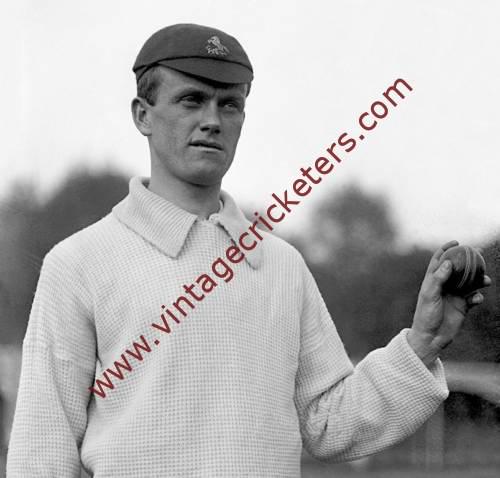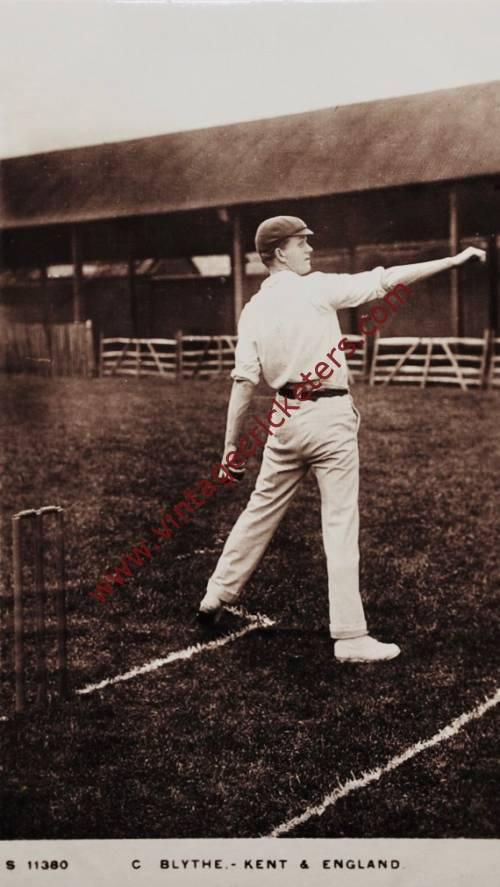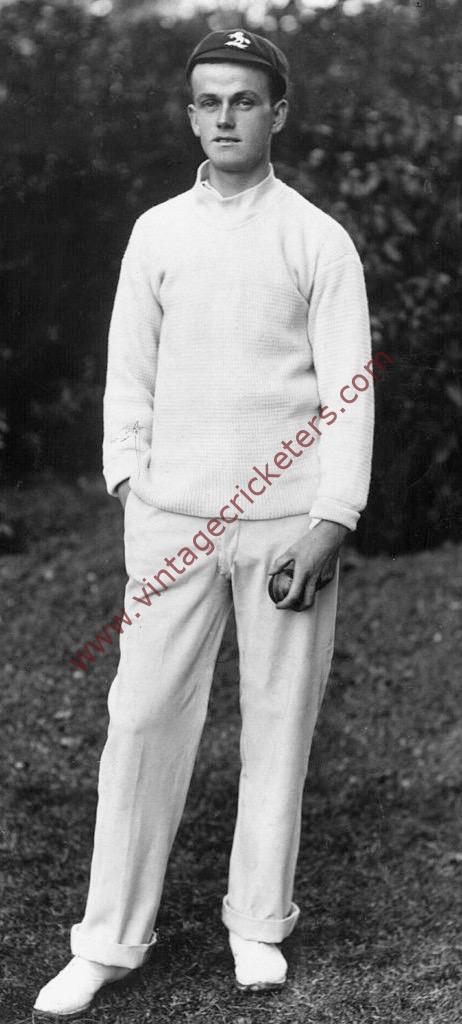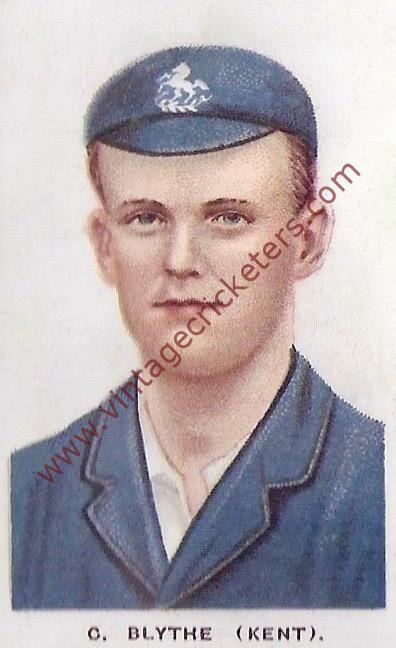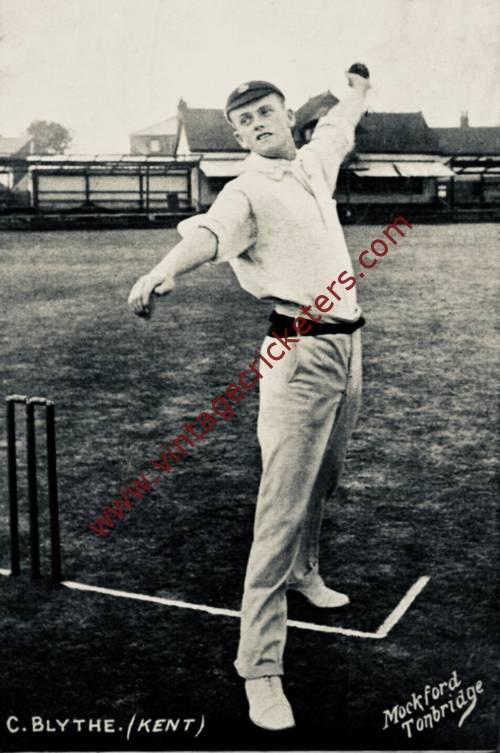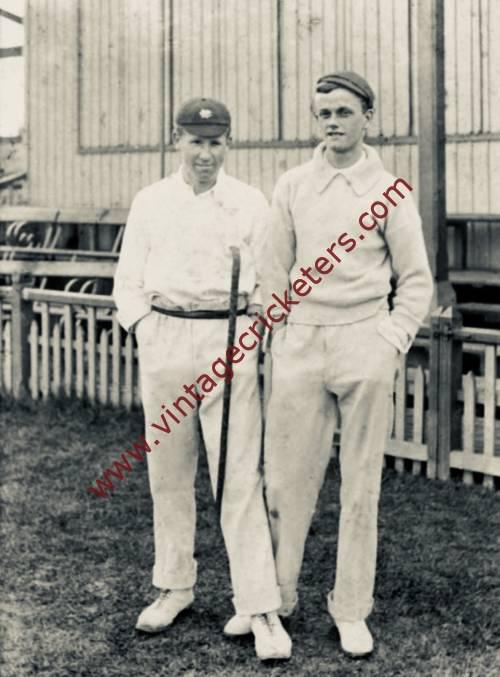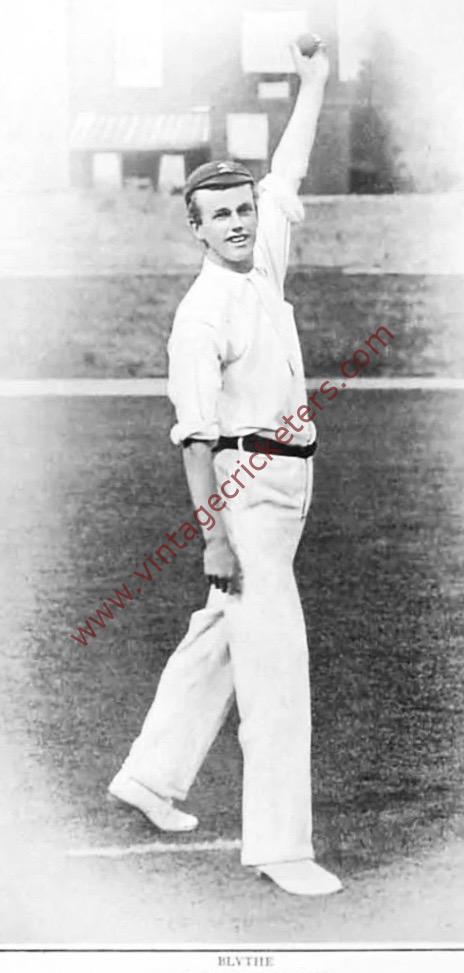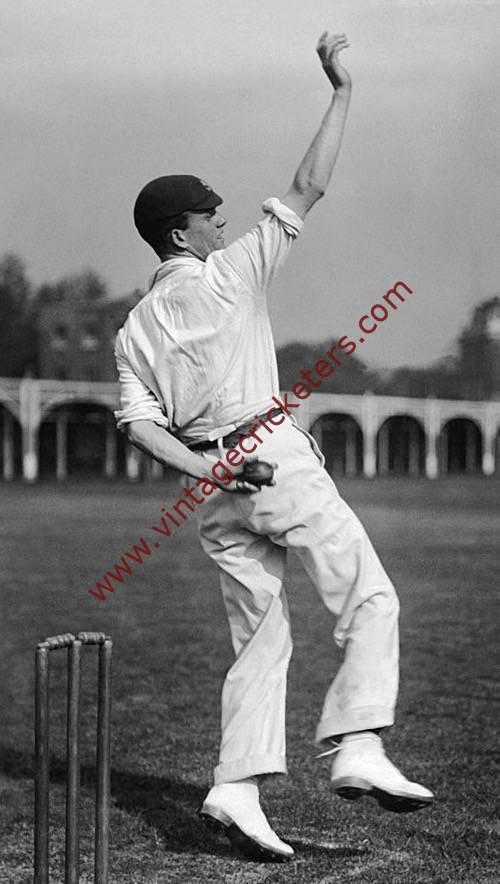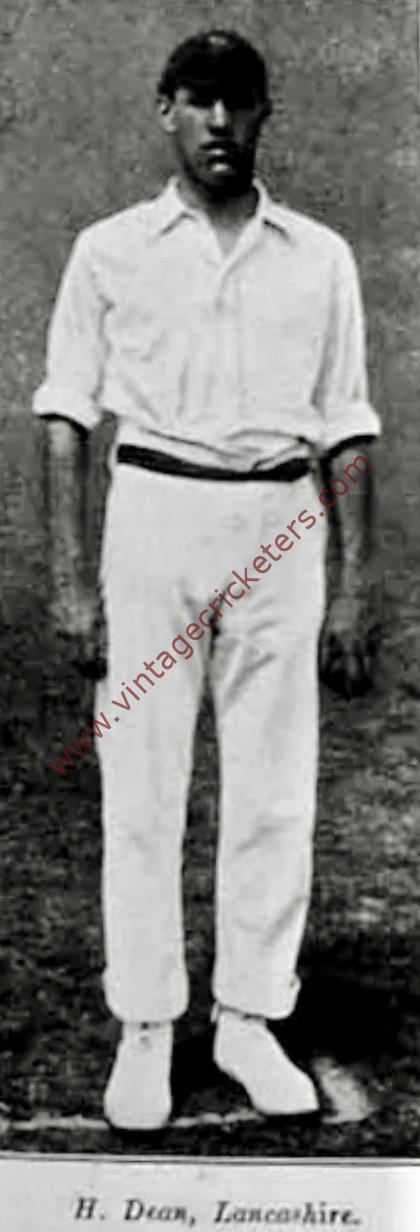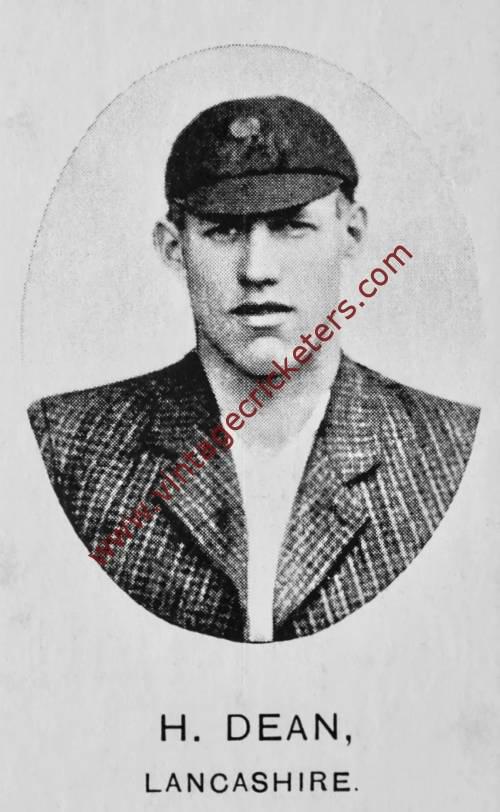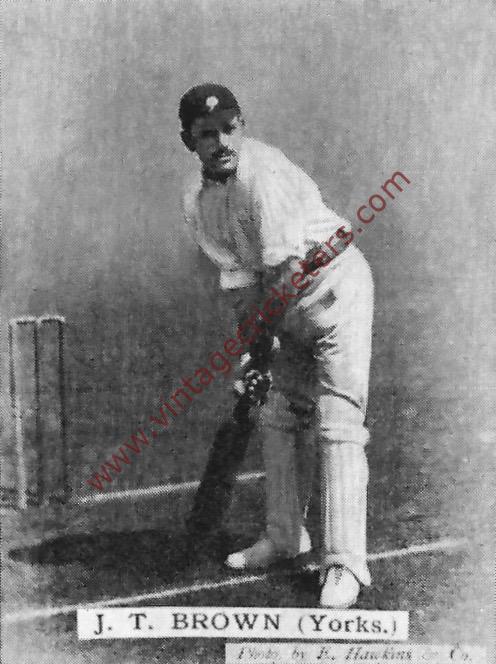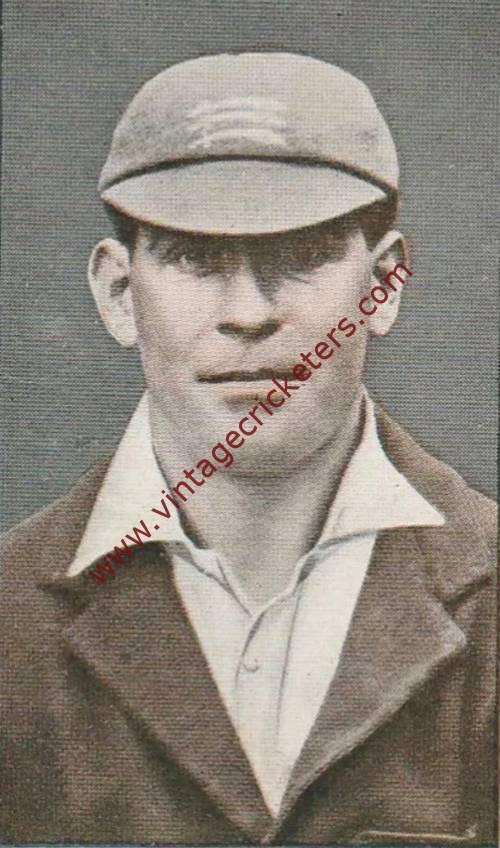Please choose your photo size from the drop down menu below.
If you wish your photo to be framed please select Yes.
Note: 16″x 20″not available in a frame.
Images can also be added to accessories. To order please follow these links
£8.95 – £49.95
Please choose your photo size from the drop down menu below.
If you wish your photo to be framed please select Yes.
Note: 16″x 20″not available in a frame.
Images can also be added to accessories. To order please follow these links
The maximum number of views of this element is reached.
Please contact the webmaster to enable unlimited views.
Deptford, London born Colin “Charlie” Blythe was one of the greatest slow left-armers, possessing a classical delivery and looping flight. His action was elegant and smooth, a few strides leading into a perfect upright sideways-on delivery. He pitched the ball up to encourage the drive into a strong off-side field, and with sufficient spin to trap any batsman unwise enough to try and hit against it. He varied his pace well, and was deceptive through the air, with more pace than most batsmen realised until too late.
He began his cricket career with a trial for Kent after having attended a match between Kent and Somerset at The Rectory Field, Greenwich in July 1897. where he was asked to bowl some warm up deliveries in the nets to Kent all-rounder Walter Wright. Kent captain William McCanlis, who was standing nearby, liked what he saw. McCanlis offered Blythe a trial at the Angel Ground where Kent ran their “Tonbridge nursery”, a training centre for younger players which became renowned for producing top-class cricketers, including Blythe, Arthur Fielder and Frank Woolley.
Blythe was successful at the trial and was immediately engaged by the club as a trainee bowler. He joined the nursery ahead of the 1898 season, taking lodgings in Tonbridge. The regime at the Angel Ground was one of intensive practice, generally in the nets, with match experience being gained in local club cricket. It was here that Blythe learned the key cricketing skills such as line and length bowling and variations in the flight and bounce of the ball which he would deploy with great success in his first class career. On Wednesday, 20th July 1898, Blythe made his début for Kent’s Second XI in a two-day Second XI Championship match against Sussex Second XI at the County Cricket Ground, Hove. Sussex won by 8 wickets. Blythe bowled in the first innings only and took 1-28. He batted at number 11, last in the order, scoring 0 and 8, both not out.
Blythe continued to make progress at Tonbridge through the 1899 season in which he took 105 wickets in local matches. On Monday, 21st August 1899, he made his first class debut for Kent in the County Championship match against Yorkshire at the Angel Ground, which he now regarded as his “home ground”. Kent, whose season to date had been poor, surprisingly won the match by 8 wickets against the Championship favourites. Yorkshire, captained by Lord Hawke, won the toss and decided to bat. Somewhat sensationally, Yorkshire were quickly reduced to 18 for 3 by Kent captain Jack Mason, who took all three wickets for just one run. The situation changed when Frank Mitchell came in as, with support from Ted Wainwright and George Hirst, he began to punish the Kent bowlers. The score had reached 86 for 4 with Mitchell 55 not out when Mason decided to introduce Blythe into the attack. With his first ever ball in first class cricket, Blythe pitched it just off the wicket and it turned to beat Mitchell’s lunge and remove his leg-side bail. He took another wicket in the second innings and retained his first team place in each of the three remaining matches. He ended the season with 14 wickets, including six in the match (three in each innings) against Surrey. The 1900 edition of Wisden Cricketers’ Almanack described him as a “new and promising bowler”.
Blythe played his first full season of county cricket in 1900, which was a wet summer. Kent’s opening match was against Yorkshire at the old Private Banks Sports Ground in Catford and they lost by 131 runs. Play did not start until 4pm on the first day. In the first evening, Blythe’s first dismissal of the season was actually a catch. He caught Jack Brown off Bill Bradley and Yorkshire were struggling at 32 for three. They were soon struggling even more at 32 for four when Bradley returned the favour and caught Ted Wainwright to give Blythe his first wicket of the season. Yorkshire reached 116 for seven at the close. Next morning, they were all out for 163 (Blythe 1-40). Kent could only manage 112 in reply and Yorkshire progressed to 232 for five at then end of day two with Wainwright scoring a century. Yorkshire soon lost their last four wickets (Lord Hawke was injured and could not bat) on the final morning and were all out for 260 (Blythe 2-53) but this gave them a lead of 311 in difficult batting conditions. It was too high a target for Kent and they were dismissed for 180. The next match against Gloucestershire, eleven days later, was also at Catford and rain-affected. No play was possible on the second day and the match was drawn. Blythe, however, did achieve his first five wickets in an innings in first class cricket by taking 5-71 in the Gloucestershire first innings and beating his previous best return of 3-15 against Surrey in 1899. He then took three of the four wickets that fell in the second innings for only 13 runs. Scoble said it was “a warning signal of what was in store”.
The big event in Kent cricket in 1900 was the opening of the new pavilion at the St Lawrence Ground in Canterbury and there were no first class matches at the ground until the start of Canterbury Week on Monday, 6th August, when Kent played Lancashire. At this point of the season, Blythe had taken 56 wickets in fourteen matches at 22.50 with just three 5 wicket returns. His first match at Canterbury was, Blythe’s biographer Christopher Scoble says, “the turning point”. In the last eight matches including the Lancashire one, Blythe took 58 wickets at 14.50 and reached a high standard that would be maintained for the next fourteen seasons.
In the Lancashire match with the pavilion now open, Kent won the toss and elected to bat. Play started on time but only fifty minutes were possible before the first day was washed out. Kent had made 23-1. Following an overnight storm which demolished numerous tents around the ground, Kent resumed at lunchtime on Day 2 and, in difficult batting conditions, were dismissed for 139 of which Jack Mason scored 73. Lancashire’s batsmen struggled too, especially against Blythe who took 6-40, but they did gain a first innings lead of 19 before they were all out for 158. Kent reached 81-1 at the close. Their batting was much better in their second innings and, with play uninterrupted on the final day, they advanced to 279 all out for a lead of 260 but with just over a couple of hours left in which to try for a result. With an outstanding contribution from Blythe, who took 5-32, they nearly did it but time ran out and the match was drawn with Lancashire hanging on at 82-8. In his first Championship match at the County headquarters, Blythe had taken 11-72. Blythe was given a standing ovation as he left the field and the Kent club members spontaneously “passed the hat” for a collection. This realised £7 1s 6d, a not inconsiderable sum, and that was presented to Blythe who was afterwards described the Kentish Express as “the hero of the match” and the “best colt of the year” who will become “the deadliest bowler in England”.
Blythe made a great impression in his first full season, taking a total of 114 wickets at an average of 18.47 with his best innings return being the 6-40 against Lancashire. He took five wickets in an innings eleven times in all and took ten wickets in a match twice, including the eleven against Lancashire. Scoble commented that “the summer of 1900 marked the uncompromising arrival of Blythe upon the English cricket scene” and, largely because of it, Kent finished third-equal in the County Championship, their best performance for ten years. They tied with Sussex but were a long way adrift of champions Yorkshire and runners-up Lancashire, the two Roses Counties having transformed the competition into a “two-horse race”. Blythe was one of 17 bowlers who took 100 wickets in the season and, among these, his average was fifth-best behind Wilfred Rhodes, Schofield Haigh, Walter Mead and Johnny Briggs.
Blythe was less successful in 1901 as he took 93 wickets at the much higher average of 23.12. Even so, he was one of 24 bowlers who took 90 or more wickets in the season and his average amongst those was 14th. His best analysis was 7-64 and there was one match in which he took ten wickets. Kent slipped to seventh in the Championship with all the sevens: they finished seventh and they won, drew and lost seven each of their 21 matches.
Blythe was selected for his first overseas tour to Australia in the winter of 1901-02 as a member of Archie MacLaren’s team and made his Test debut at Sydney in December. He played in eight first class matches on the tour, taking 34 wickets at 20.91. His best return was 5-45. In 1902 Kent again finished seventh in the Championship. Blythe had a much better season and was one of 18 bowlers who took 100 wickets in the season. His tally was 127 at 15.47, his best seasonal average to date which placed him fourth overall behind Haigh, Rhodes and Australia’s Hugh Trumble. He achieved 5 wicket twelve times and 10 wicket matches three times, his best analysis being 8-42.
In 1903 Kent dropped a place to eighth but still managed a winning record of seven wins and seven draws against six defeats. Blythe was one of 17 players who took 100 wickets. He took 142, his highest total to date, at 13.75 which was his best average to date. He was the third highest wicket taker behind Rhodes and Ted Arnold; his average was second best after Walter Mead with 13.67. In recognition of his exploits in 1903, Blythe was one of the five Wisden Cricketers of the Year in the 1904 edition of Wisden. The other four players honoured were John Gunn, Albert Knight, Walter Mead and Pelham Warner. In the dedication, Wisden prophetically stated: “As he is still under twenty-five the best of him may not have been seen, but even if he should only remain at his present standard of excellence he ought with ordinary luck to be a most valuable member of the Kent eleven for ten years to come”. That is, to 1914, so Wisden was right. They were wrong, however, about his name because as they had obviously heard he was known by his nickname “Charlie”, they assumed his given name was Charles and their dedication was erroneously entitled “Charles Blythe”.
Kent improved somewhat in 1904 and won ten of their 21 matches to be placed third in the championship behind Lancashire and Yorkshire. Lancashire were clear winners but there was little to choose between Yorkshire and Kent. The match in July between the two at Harrogate was declared null and void by the umpires following damage to the pitch by overnight vandalism after the first day’s play. The umpires invoked Law 9 (illegal alteration of the pitch after the first day), but the teams decided to continue playing for the crowd’s entertainment. Blythe was playing for Kent and took 5-125 in Yorkshire’s first innings. Blythe took 138 wickets in the season. This was the second highest tally after Jack Hearne (145). Blythe’s average of 19.60 placed him third behind Hearne and James Hallows. Blythe’s best analysis was 9-30; he achieved 5 wicket innings nine times and 10 wicket matches twice.
Kent won ten of their 22 matches in 1905 and finished sixth in the County Championship. Blythe took 149 wickets which was the sixth highest tally but he was more expensive than previously, causing a higher than usual average of 21.08 which placed him 11th among bowlers with 100 wickets. His best innings return was 8-72. He achieved 5 wicket innings twelve times and 10 wicket matches five times. Blythe toured South Africa with M.C.C. and played in eleven first class matches on tour. He took 57 wickets, more than five per match, at 18.35 with a best innings return of 6-68, with four 5 wicket innings and one 10 wicket match.
In a memorable season for Kent in 1906, they won the County Championship for the first time with a record of 16 wins and 2 defeats in their 22 matches. The season had a dramatic finale. Surrey had made much of the running in the title race but their challenge faded after defeats by Kent at Rectory Field and by Yorkshire at Bramall Lane. These results left only Kent and Yorkshire in contention. Yorkshire were the favourites but, in a tense match at Bristol, they lost to Gloucestershire by one run, the smallest possible margin of victory. Kent, who defeated Worcestershire on the same day, now held the advantage. In the next round of matches, Kent and Yorkshire both won. That was Yorkshire’s last game and so, in their final match of the season at Bournemouth, Kent had to avoid defeat by Hampshire to take the title. Kent duly won by an innings and 37 runs with Blythe taking twelve Hampshire wickets, with 6-67 and 6-123. Blythe took 111 wickets at 19.90 in 1906 with a best return of 7-63. He achieved 5 wicket innings ten times and bowled four 10 wicket matches. He was 15th in the list of leading wicket takers and a long way behind his colleague Arthur Fielder who took 186 scalps. Blythe’s average placed him 8th among the 20 bowlers who took 100 wickets.
In the 1907 County Championship match at the County Cricket Ground, Northampton, Kent defeated Northamptonshire by an innings and 155 runs. Kent had batted first, having won the toss, and had then dismissed Northants for 60 and 39. The story of the match is that it was dominated by, first, the weather and then by Blythe. The first day was Thursday, 28th May, Blythe’s 28th birthday. Play could not commence until mid-afternoon and then three hours were possible before more rain intervened. Kent won the toss, batted first and reached 212 for 4. On the Friday, no play was possible because of persistent rain. The weather relented on Saturday morning and Kent were able to continue their innings. Their tactics were simply to score as many as possible as quickly as possible and they added 42 in 40 minutes to reach an all out 254 with more than an hour to go before lunch. On a wet but drying wicket, Blythe was in his element. He opened the bowling from the pavilion end and, in 16 overs, shattered Northants with a career-best return of 10-30. Northants had to follow on but, with Blythe taking 7-18, their second innings lasted only thirty overs, so Blythe had taken 17 wickets in a single day’s play. Frank Woolley was playing and he recalled in his memoir that Blythe was unlucky not to take all twenty wickets in the match (this has never been done in first class cricket). He says Blythe was affected by dropping an absolute “sitter” off his own bowling but that was in the first innings, not the second. The first wicket in the second innings was taken by Bill Fairservice so the all-twenty goal was never on once that wicket fell.
Blythe’s best Test bowling performance was against South Africa at Headingley in the Second Test of the 1907 series when he took 8-59 (15-99 in the match) .
Kent were unable to retain their Championship title and slipped to 8th in the final table, having won 12 of their 26 matches. Blythe had one of his best seasons individually, especially with his performances at Northampton and Headingley. He took 183 wickets, the same as George Hirst, and only George Dennett with 201 took more. Blythe’s average improved to 15.42 and placed him fifth among the bowlers with 100 wickets. He achieved 5 wicket innings seventeen times and 10 wicket matches six times. Blythe made his second tour Australia that winter, this time with M.C.C. He played in 11 first class matches and took 41 wickets at 22.80 with a best return of 6-48. He achieved 5wI three 5 wicket innings and one 10 wicket match.
Kent had a very good season in 1908 and were runners up in the County Championship behind Yorkshire, who were unbeaten in 28 matches. The crucial match was Kent’s season opener at Bradford Park Avenue where Yorkshire won by nine wickets. Only 249 runs were scored in the entire game. Kent also lost to Hampshire and Surrey in August. Blythe had an outstanding season and, for the first time, was the country’s leading wicket-taker, his 197 scalps putting him well clear of George Hirst (174). Blythe’s average was 16.88 (7th among bowlers with 100 wickets); his best innings return was 8-83, with 20 five wicket innings and 6 ten wicket matches. Having performed with great credit in 1908, Kent won the 1909 Championship in fine style, losing only two of their 26 matches. Blythe took 215 wickets, 48 wickets more than anyone else, and he was again the national leader. His average of 14.54 was second among bowlers with 100 wickets, behind Schofield Haigh’s 13.95. Blythe’s best innings return was 9-42. He achieved 23 five wicket innings and 7 ten wicket matches. Blythe made his second tour of South Africa in his last overseas season that winter. He played in 10 first class matches and took 50 wickets at 15.66 with a best return of 7-20, with one 10 wicket match and three 5 wicket innings.
Blythe took two hat-tricks in his career, both of them within the same fortnight at the end of June and the beginning of July 1910. Kent retained the County Championship title with a new but short-lived percentage system (wins to matches played) working in their favour. They won 19 of 25 matches for 76.00% and were well clear of runners-up Surrey who won 16 of 28 for 57.14%. Blythe took 175 wickets and was second after Razor Smith (247). His average of 14.26 was third best among the bowlers who took 100 wickets, after Jack Hearne and Razor Smith. Blythe’s best innings return was 7-53, bowling 18 five wicket innings and four 10 wicket matches.
The 1911 County Championship was the first to award points for first innings lead and it created controversy for Kent who finished marginally second behind Warwickshire. If the 1910 system had been retained, Kent would have won a hat-trick of titles. The key match was their nine-run defeat by Surrey at The Oval in late August which, subject to Warwickshire winning their final match, decided the outcome. Blythe took 138 wickets at 19.38 with a best analysis of 8-45. He had the 7th highest number of wickets and the fifth best average.
Kent had another good season in 1912 but Championship success eluded them and they finished third behind Yorkshire and Northants, but as in 1911, they would have won the title under the 1910 percentage system, having won 14 of their 26 matches. Blythe had his best season in statistical terms as he was both the leading wicket taker and top of the bowling averages. He took 178 wickets at 12.26 with a best return of 8-36. He achieved 16 five wicket innings and 8 ten wicket matches.
Kent then won their fourth County Championship in eight seasons with 20 victories in 28 matches in 1913. Blythe again topped the bowling averages with 16.34 and his tally of 167 wickets was third highest behind Major Booth (181) and Bill Hitch (174). Blythe’s best bowling return was 7-21 with 15 five wicket innings and 3 ten wicket matches. In 1914 Kent won 16 of their 28 matches and finished third behind Surrey and Middlesex. Their last match was at Bournemouth against Hampshire and they lost it by an innings and 83 runs. This match finished on Wednesday, 2nd September, a full four weeks after War had been declared and many players, including Blythe, had already enlisted in the Armed Forces. Blythe had made his final appearance at Lord’s a week earlier, on 27th and 28th August, when Middlesex defeated Kent by 298 runs. Blythe took 5-77 and 2-48. In his last season, Blythe again took the most wickets and topped the bowling averages. His tally of 170 wickets was eight more than Alec Kennedy’s 162 and his average of 15.19 marginally better than Alonzo Drake’s 15.30. Blythe’s best innings return was 9-97, with 16 five wicket innings and 5 ten wicket matches.
Between 1899 and 1914, Blythe played in 439 first class matches taking 2,503 wickets at an average cost of 16.81 runs per wicket. He took 5 wickets in an innings 218 times, 1o wickets in a match 71 times and 100 wickets in a season 14 times. As of 2017, Blythe is one of only 33 players who has taken 2,000 first class career wickets and he is ranked 13th in the list, but he had a much shorter career than any of the first twelve. Among the bowlers with 2,000 plus wickets, his average of 16.81 is the sixth best after those of Alfred Shaw, Schofield Haigh, Johnny Briggs, Brian Statham and Wilfred Rhodes.
In Test cricket Blythe represented England 19 times between December 1901 and March 1910, taking part in seven series. He took exactly 100 wickets with an average of 18.63. He took nine 5 wicket innings and four 10 wicket matches, with a best innings return was 8-59 against South Africa at Headingley in 1907 and his 15-99 in the same match was his best Testmatch return.
As a batsman, Blythe was never more than occasionally useful and was always a tail-ender who batted low in the order. He had 587 innings in his career scoring 4,443 runs at an average of 9.87 per dismissal. He never scored a century but did achieve five half centuries. His highest score was his innings of 82 not out at Trent Bridge in 1904. Like most specialist bowlers, Blythe fielded in the outfield and he held 206 career catches.He had 31 Test innings scoring 183 runs at the average of 9.63. His highest Test score was 27 and he held six catches.
Off the field, Blythe played the violin and Harry Altham, writing in Barclay’s World of Cricket, said that his slow left-arm action “reflected the sensitive touch and the sense of rhythm of a musician”, the left arm emerging from behind his back “in a long and graceful arc”. Blythe, who had complete mastery of flight and spin, bowled consistently to a full length and made effective use of his fingers at the point of delivery to determine if the ball would be an orthodox break or a late in-swinger, either of which was a difficult ball to face on a pitch that helped the bowler. Although he was ostensibly a slow-paced bowler, Blythe sometimes bowled an “arm ball” which was decidedly fast and, in general, he had more pace than would be expected.
In his Golden Ages, A. A. Thomson praised Blythe as Wilfred Rhodes’ “historic rival as a slow left-hand bowler”. Thomson declared Rhodes and Blythe to have been “the greatest of slow left-hand bowlers” but stated a slight personal preference for Rhodes. He qualified his opinion by admitting that many better judges, including Ranjitsinhji, considered Blythe to be “the more difficult to play (against)”. As well as Ranji, all the leading batsmen greatly respected Blythe and Gilbert Jessop wrote in his book A Cricketer’s Log that his particular bêtes noires as bowlers were Blythe, Monty Noble and Tom Hayward.
Blythe is depicted as the bowler in Albert Chevallier Tayler’s oil painting, Kent vs Lancashire at Canterbury, commissioned by Kent at the suggestion of Lord Harris to commemorate the club’s first official County Championship title in 1906. Harris made two conditions: the ground had to be Canterbury; the bowler had to be Colin Blythe. Harris’ choice of Blythe for this honour is echoed in Altham’s history: “But when all is said, it is the figure of ‘Charlie’ Blythe that stands out above his fellows as the greatest factor in the County’s success”.
Altham went on to say that Blythe elevated bowling “from a physical activity onto a higher plane” and summarised him as “practically unplayable” on a “sticky wicket”. Technically, Altham says, Blythe’s strengths were “the quickness of his break and rise (of the ball) from the pitch, combined with his perfect length”.
Blythe suffered from epilepsy, the onset of which may have been during his teenage years. In 1907 there are records of his condition which may have been exacerbated by competing responsibilities at home and on the cricket field. Despite his epilepsy, Blythe still enlisted as a soldier in the British Army when The Great War broke out in August 1914. He had intended to announce his retirement from cricket at the end of the 1914 season, and he confirmed it in September after the season had been brought to a premature close.
Blythe enlisted in the Kent Fortress Royal Engineers (Fortress Engineers) as a member of the No. 1 Reserve Company. This was in Tonbridge at the end of August. Bill Fairservice, Wally Hardinge and Northamptonshire’s Claud Woolley (brother of Frank) were also in the Fortress Engineers. In 1917, because of heavy losses in the Battle of the Somme, the Army began to move men from Royal Engineers (RE) units into combat units. In August, Blythe was posted to an RE camp at Marlow for combat training. The authorities were by this time encouraging charity cricket matches and on Saturday, 18th August, Blythe played for an Army and Navy team at Lord’s against a combined Australian and South African team. It was to be his last ever match. Accepting that he would not play first class cricket again, he agreed to become coach of cricket at Eton College after the War ended.
Soon afterwards, Blythe was posted to the 12th Pioneer Battalion of the King’s Own Yorkshire Light Infantry, which had been raised in Leeds and mostly consisted of Yorkshire miners. He attained the rank of sergeant. Working in the Ypres sector of the Western Front, the battalion was mainly engaged in laying and maintaining light railway lines to allow easy passage of men, equipment and munitions across the area. On 8th November 1917, during the Battle of Passchendaele, Blythe was working on a railway line between Pimmern and Forest Hall near Passchendaele when he was killed instantly after shrapnel from a shell burst pierced his chest.
He is buried in the Oxford Road Commonwealth War Graves Commission Cemetery, near Ypres in Belgium. Like his Kent and England colleague Frank Woolley, Blythe is commemorated in Tonbridge Parish Church and has a road in North Tonbridge named after him. There is a memorial to him at the St Lawrence Ground, now more popularly known as The Spitfire Ground. Inscribed in block letters on the west face of the plinth is the dedication: “To the memory of Colin Blythe of the Kent Eleven who volunteered for active service upon the outbreak of hostilities in the Great War of 1914-18 and was killed at Ypres on the 18th Nov 1917. Aged 38 he was unsurpassed among the famous bowlers of the period and beloved by his fellow cricketers”. [NB The date is wrong: Blythe was killed on the 8th].
Some extracts from Blythe’s Wisden obituary: “The news that Blythe had been killed in France was received everywhere with the keenest regret… the loss is the most serious that cricket has sustained during the war… That Blythe was a great bowler is beyond question. He had no warmer admirers than the many famous batsmen who had the satisfaction of making big scores against him. So far as I know they were unanimous in paying tribute to his remarkable powers. He was one of five left-handed slow bowlers of the first rank produced by England in the last forty years, the other four being Peate, Peel, Briggs, and Rhodes…. Blythe had all the good gifts that pertain to the first-rate slow bowler, and a certain imaginative quality that was peculiarly his own. Very rarely did he get to the end of his resources. To see him bowl to a brilliant hitter was a sheer delight. So far from being disturbed by a drive to the ring he would, instead of shortening his length to escape punishment, send up the next ball to be hit, striving of course to put on, if possible, a little extra spin. He had, too, far more pace than most people supposed. The ball that went with his arm often approached the speed of a fast bowler and had of course the advantage of being unsuspected. On this point Fred Huish, the wicket-keeper, can be very illuminating… To sum up his career in a phrase, he will live in cricket history as the greatest Kent bowler of modern days.”
In 2009, when the England cricket team visited the Flanders war graves, they laid a stone cricket ball at Blythe’s grave. England’s then captain Andrew Strauss said: “It was a deeply moving and humbling experience”.
NB this is an identical image to Image 7, however for whatever reason the man-made background structures have been “doctored” out.
| Weight | N/A |
|---|
